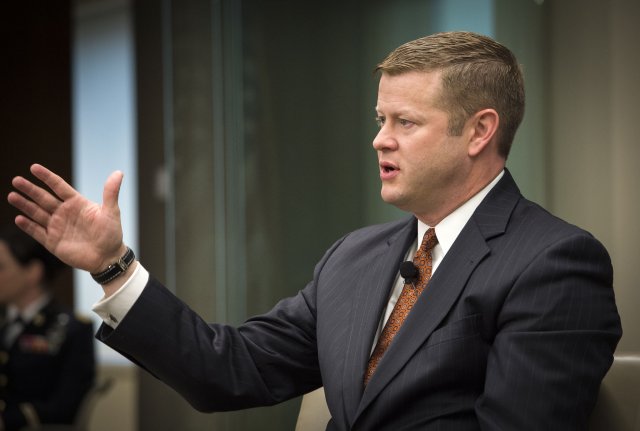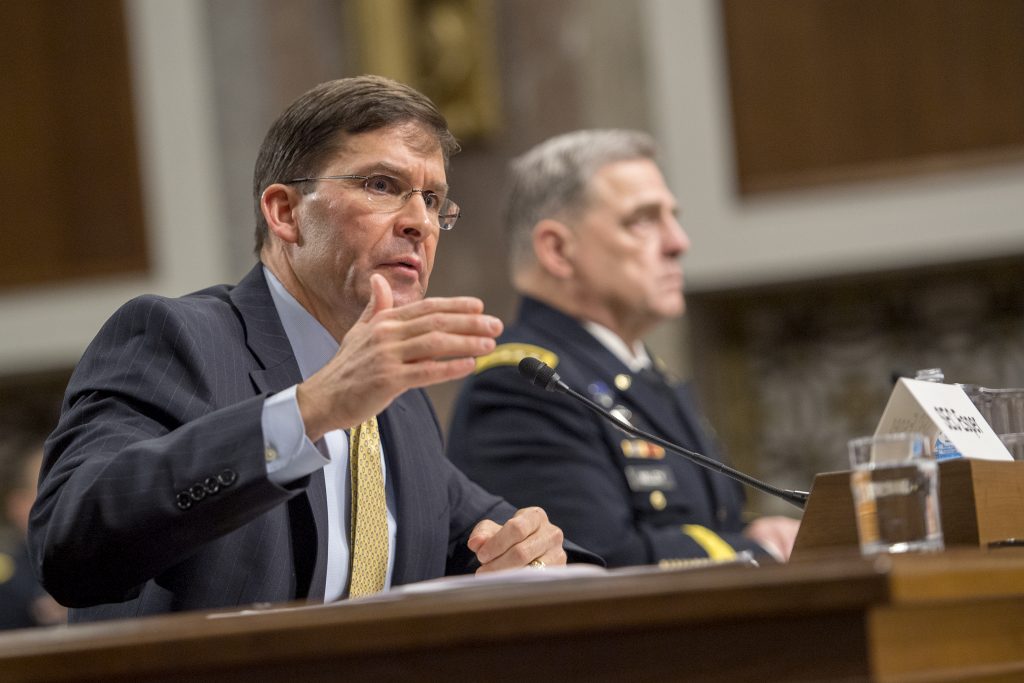
Ryan McCarthy
PENTAGON: Army Secretary Mark Esper and Chief of Staff Mark Milley play distinct but complementary roles in the service’s push to modernize, Army Undersecretary Ryan McCarthy told me this morning, dismissing the idea of any “tension” between their priorities.
As the service’s most senior professional soldier, with three decades in uniform, Gen. Milley assesses the global military balance, envisions what future warfare will require, and then lays out what the Army needs, embodied in its Big Six modernization priorities. As the senior civilian, with a background both in business and on Capitol Hill, Sec. Esper then works on how to fund and deliver those needs.

Army Secretary Mark Esper (left foreground) and the Chief of Staff, Gen. Mark Milley (right background), testify before the Senate.
Heartburn at High Levels
Army staff summoned me to McCarthy’s E-ring office after an article I wrote last week suggested the Secretary and Chief of Staff showed “a difference in emphasis” in their statements on modernization, “with Milley’s rhetoric consistently grander and Esper’s more evolutionary.” (Normally we don’t quote ourselves, but in this case we became part of the story).
I’d thought the issue settled because Esper had given me a pretty good answer on how to reconcile Milley’s revolutionary goals with his own evolutionary means, which I spent most of the article explaining. In brief, you build weapons with technologies that are mature today but they’ve got plenty of room to upgrade with radically new tech when it’s ready.
But apparently 1,000 words explaining how the Army balanced the two goals didn’t outweigh the initial 100 words noting that the two goals weren’t identical, because the story inspired heartburn at high levels.

Division of Labor: Army Secretary Mark Esper cheers while Chief of Staff Gen. Mark Milley plays the cymbals at a pep rally before the Army-Navy game.
McCarthy Makes It Clear
When I asked McCarthy about what I called a “productive tension” between revolution and evolution, he replied: “Well, Sydney, I don’t think it’s tension.”
“I spend a lot of time with those guys,” McCarthy went on. “The chief is identifying capabilities that he knows we will need in order to maintain overmatch against near peers in the future, (e.g.) long-range precision fires to maintain range and rate of fire over and above any potential adversary.” In other words, Milley chooses the destination, while “the secretary… is more of a ‘how to get there’ (role).”
Both serve American soldiers, just in different ways, McCarthy said: “We have to get them the capabilities they need to win. The chief has to identify those capabilities; we have to go out there and procure them….That’s really where he (Sec. Esper) and I play.”
As Esper, McCarthy, & co. figure out the mechanics and programmatics of how to build the force Milley envisions, the ability to upgrade is essential. But it’s not a trivial engineering challenge to build, say, a vehicle today that can be upgraded with radically new technology two, five, or 10 years from now. Today’s design has to include unused space, weight-bearing capacity, electrical power, and cooling capacity to accommodate new gear, the power it consumes, and the waste heat it generates.
Trickier still, today’s design needs to have a physical structure, power supply, onboard computing, etc. etc. that lets you plug in upgrades — including new technologies not even invented when you first drew up the blueprints. The best-practice approach to do this is to set strict standards for how everything fits together and design components as interchangeable modules. The term of art for this approach, which you hear in the mouths of more and more Army leaders, is “modular open architecture.”
If a company’s proposed solution does not work with an open architecture approach, the Army will consider that a strike against them, McCarthy said: “Secretary Esper, taking his business experience, emphasizes if there is better capability that may exist today, we’ll look at procuring that — but only and only if it has an open systems architecture that has room for substantial upgrades over its life.”
So will offering a proprietary solution disqualify you, even if you’re offering an otherwise impressive technology? “It depends,” McCarthy said frankly. “We will pay for that (technology), even if it is proprietary, if it is that good, but that’s a cost:benefit analysis that has to be conducted by the Army.”
Modernizing a military is all about tradeoffs and balance: between seeking the best individual technologies and making sure all the technologies work well together, between striving for breakthroughs and making sure you can get something that works here and now. You can’t do everything you want at once. Inevitably, there’s some tension.
Edited for clarity at 8:05 pm
Move over FARA: General Atomics pitching new Gray Eagle version for armed scout mission
General Atomics will also showcase its Mojave demonstrator for the first time during the Army Aviation Association of America conference in Denver, a company spokesman said.


























